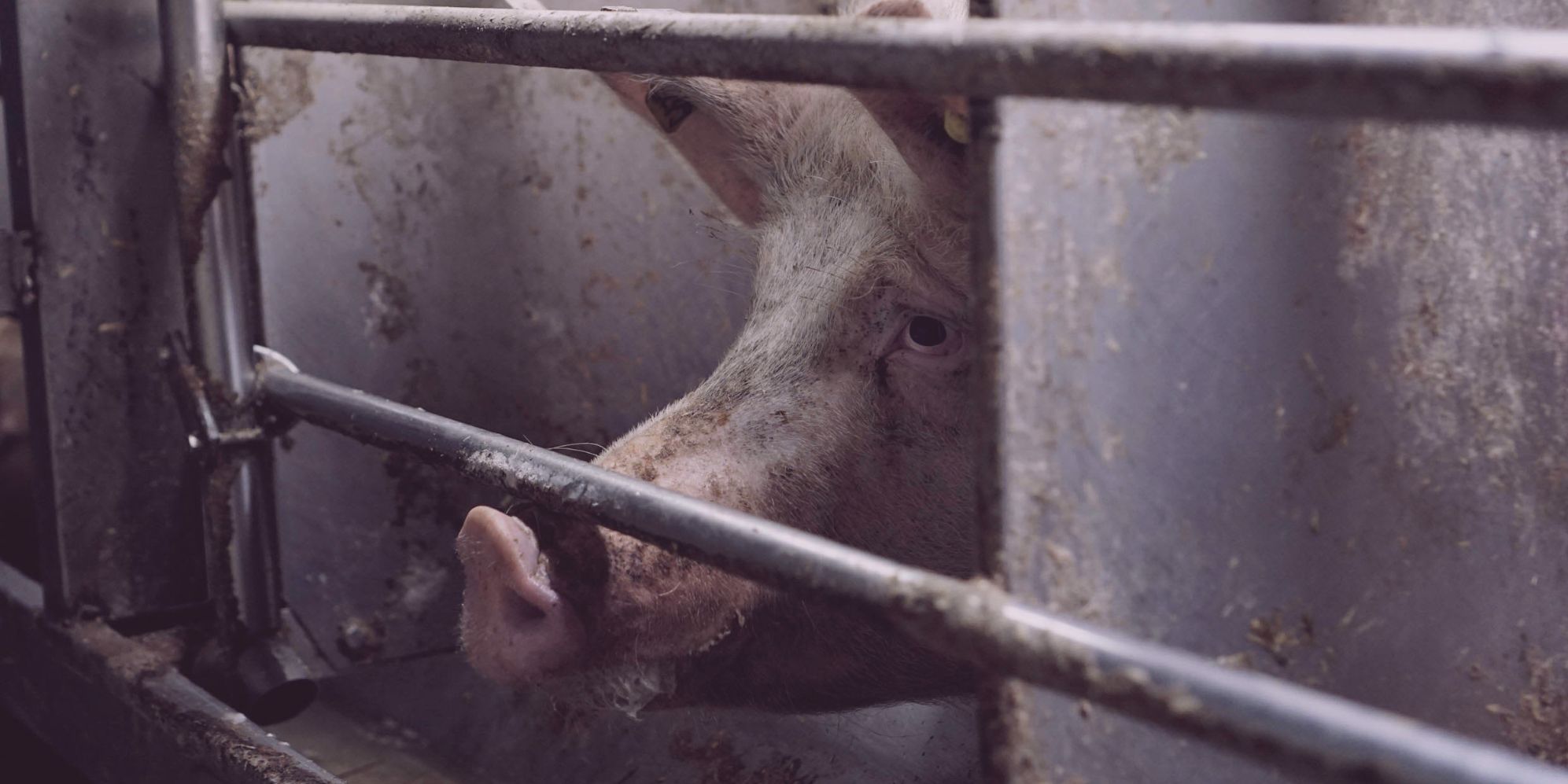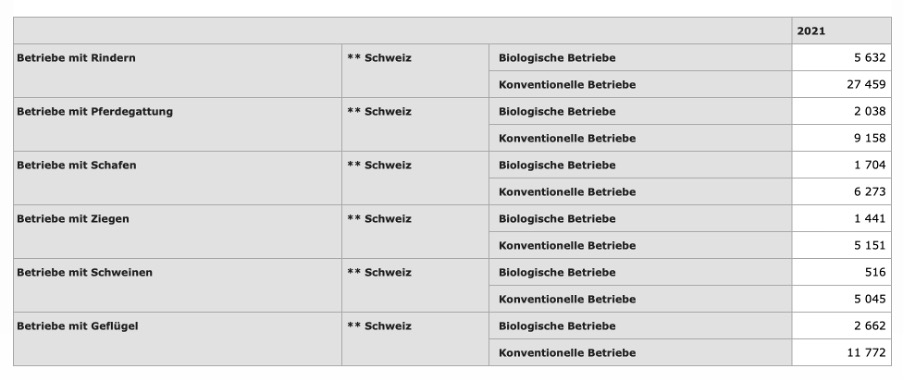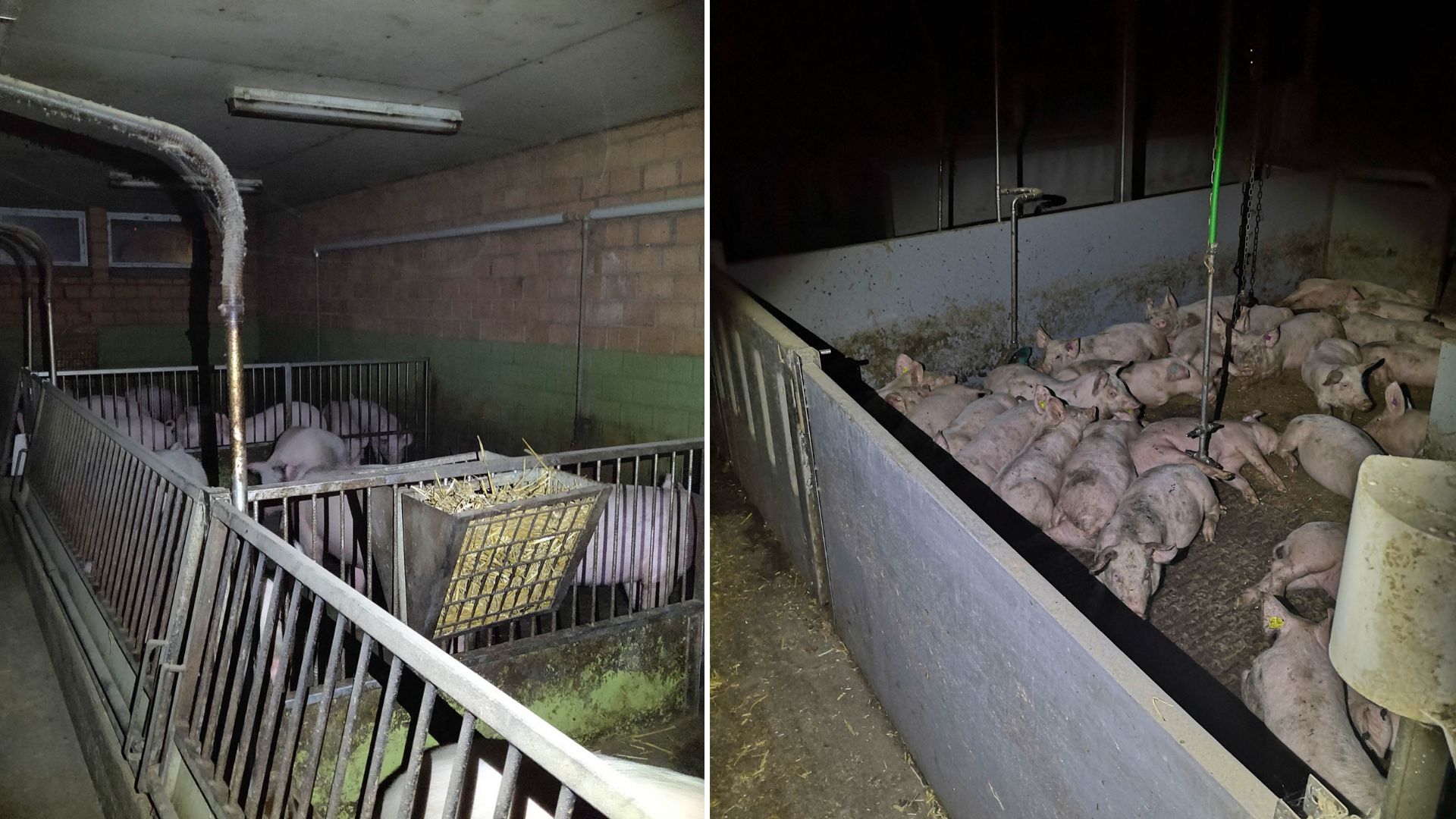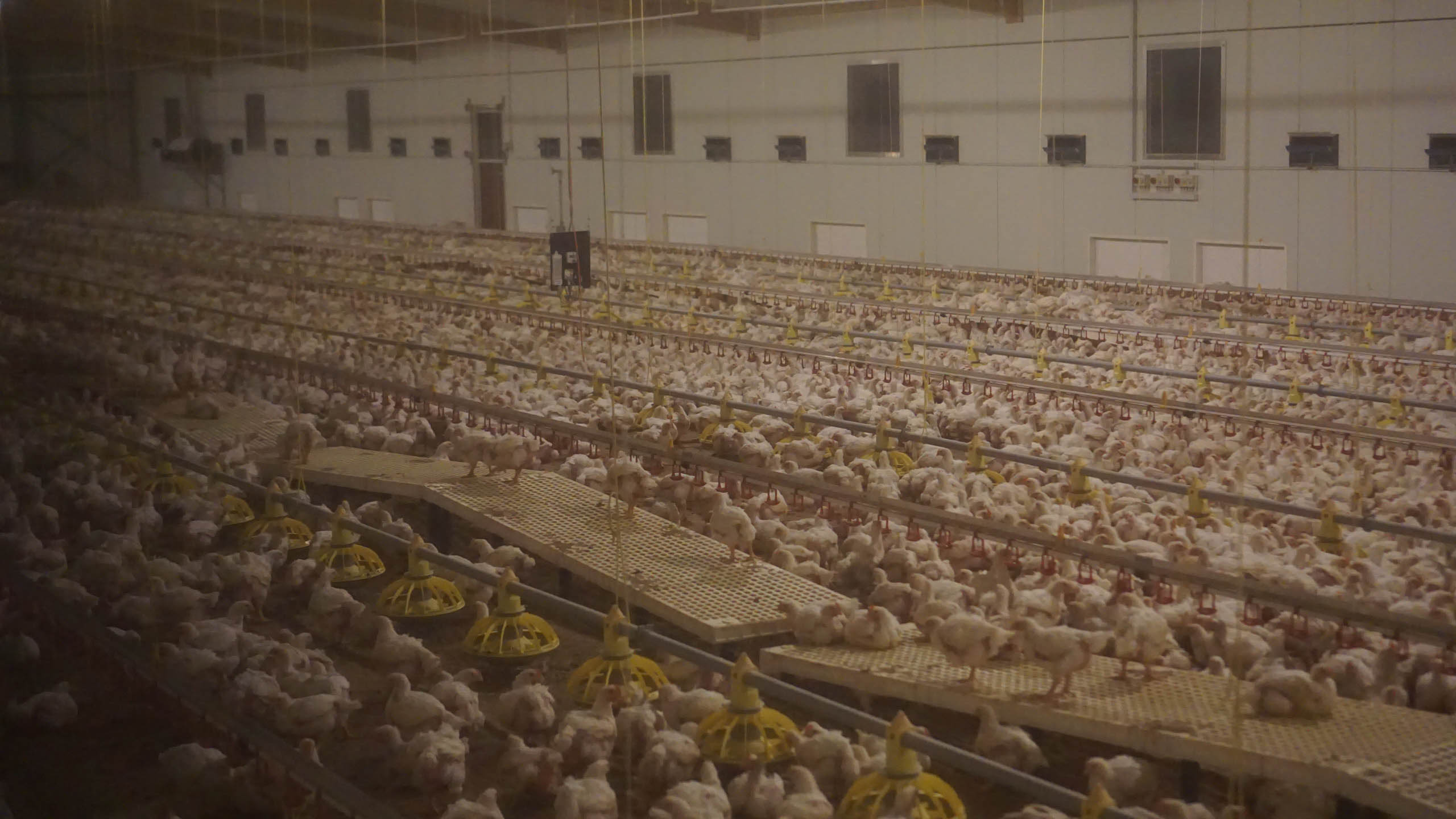
Why the Initiative to Ban Factory Farming is not Progressive
In September, Swiss citizens will vote on the Initiative to Ban Factory Farming (MTI). According to the MTI, the goal is to “respect the dignity of the animals in agricultural animal farming, as embodied in the constitution.”1 The following article discusses two problematic aspects of the initiative. First, the term “factory farming” does not refer to a fixed quantity; neither the federal government nor the initiative committee settle on a definition, thus hindering a common understanding of the initiative that could block the implementation of the demands. Secondly, the MTI is committed to animal welfare - it is solely concerned with improving the living conditions of non-human animals in a speciesist production system.
NOTE: Read the article in German if possible (all quotes have been translated into English.). Among other things, the article discusses the word “Massentierhaltung” (= keeping animals in large numbers/masses). There is no congruent French or English translation - the word is most commonly translated as “Élevage intensif” respectively “Factory Farming”. In the following the word “Massentierhaltung” is nevertheless translated with “Facotry Farming”.
What is factory farming?
a.) General definition and separation from related terms
The term “Massentierhaltung/Factory Farming” refers to a modern and industrialized form of animal agriculture that is entirely geared towards maximizing profit. Typically, large numbers of non-human animals are kept in confined spaces in order to efficientlly increase the production of flesh, milk, fur, eggs, etc.. The terms “intensive” or “industrial farming” may be understood more broadly than the term “Massentierhaltung/Factory Farming”; the latter is usually linked to industrial animal farming on large farms. Small farms can also intensively exploit non-human animals. This distinction becomes important in the discussion that follows.
b.) Defining factory farming: Massentierhaltungsinitiative
Article 2 of the initiative text makes an attempt to define “factory farming”:
“Factory farming refers to industrial livestock production to obtain animal products as efficiently as possible, where animal welfare is systematically violated.”2
Article 2 refers to the concept of “industrial animal farming”. According to the initiative text, the violation of animal welfare consists in restrictive space conditions, the prevention of social interactions and the denial of outdoor exercise.
The MTI’s demand is to expand the space in barns according to the Bio-Suisse specifications.
For a pig weighing 110kg, this would result in the following change:
Minimum standards under current law: 0.9m²
Minimum standards if initiative passes: 1.65m² (incl. outdoor area)
Conventional Animal Farming (minimum standards): The term “conventional animal farming” refers to a form of animal agriculture that only complies with the minimum legal requirements.3 Most farms that are labeled as factory farms follow conventional guidelines.
Article 2 indicates that the total number of non-human animals on a farm plays a minor role in determining when the new regulations will apply. An example might help to shed some light on the matter: A conventionally run pig farm can house 1,000 pigs. However, the pigs do not all stay in one area. Their living areas are divided into pens. Per pen, the pigs live according to the minimum standards, which corresponds to 0.9m² for each pig. A pen designed according to conventional standards can be implemented by a large farm as well as by a small farm. Whether 1,000 pigs live in a pen or just 100 does not necessarily affect the space conditions within the pens.
If the MTI is referring to the minimum space regulation when refering to the term “Massentierhaltung/factory farming”, the end goal would be the improvement of conventional animal farming as such.
But this is not what the initiative demands. The initiators state that only 5% of all farms - especially “large industrial farms” - would be affected by the new regulations:
“According to the Federal Council, only about 5% of farms would be affected by the initiative. These include mainly the large, factory-style feedlots that keep up to 27,000 chickens, 1,500 pigs or 300 cattle in one barn.”4
Again, in another place they state:
“According to the Federal Council’s regulatory impact assessment, about 3,000 farms would be affected by the initiative. That’s only about 5% of all farms producing animal products.”5
This would not result in a revision of conventional “livestock farming” per se, but would only affect large farms that hold the total amount of non-human animals mentioned in the quote. Further, this means that if the initiative is approved, only 5% of all practicing farms would be affected. However, many more farms follow the restrictive conventional standards.
Articel 2, that identifies the systematic violation of animal dignity in industrial animal farming, contradicts with the statement that only 5% of farms are guilty of factory-like non-human animal farming. The percentage of all farms that keep non-human animals according to the legal minimum requirements is much higher than 5%. Below is a list of the number of conventional farms compared to the number of organic farms in 2021 in Switzerland:
 Source: Bundesamt für Statistik6
Source: Bundesamt für Statistik6
What does this mean regarding the realization of the initiative? If the concept of Massentierhaltung/factory farmingis linked to the size of the farm, (= approximately 27,000 chickens, 1,500 pigs or 300 cattle) the revision of the farming conditions does not apply to smaller to medium-sized farms. Although the non-human animals on smaller farms are not kept “en masse” in terms of numbers, they are subjected to the same restrictive space conditions as on large farms (e.g. 0.9m² space per pig per pen). For example, in the case of farms which raise pigs, conventional farms account for almost 91% (5,515 as opposed to 516 organic farms).
“Up to 27,000 animals are allowed to be kept in one hall in Switzerland. 27,000 individuals is clearly a “mass.” Many animals live in barren, confined barns and have little or no outdoor space.”5
However, barren, confined housing conditions are not peculiar to large-scale farms. There are barns where “only” 100 pigs are being fattened, but these pigs live in the same restrictive conditions as pigs in a farm that holds 1,500 non-human animals.
Yet, the MTI neither subscribes to the conclusion that only large farms will have to adjust their conditions, but promises to raise the “undignified” living conditions of all non-human animals to the organic standards:
“Raising the minimum requirements in animal farming is intended to ensure that the quality of life for all animals is enhanced. Pigs and cows, if allowed out, are often merely standing on concrete.”5
Another problem lies in the layout of the initiative. According to the initiative text, the planned measures to abolish factory farming consist of adapting the Bio-Suisse guidelines to large-scale farms. However, this suggests a false image of factory farming, insofar as factory farming is associated with population size. Organic farms are also allowed to raise non-human animals on a massive scale. Even under Bio-Suisse standards, it is allowed to keep 4,000 - 8,000 chickens in one single area. Organic standards do not guarantee factory farming-free housing conditions (VgT has documented organic factory farming).7 Furthermore, Bio-Suisse only regulates the maximum limit for chickens - all other animal species are not subject to a maximum stocking regulation. Thus, the official Maximum Livestock Regulation - the legal text that specifies all maximum numbers - continues to apply to the other species. If the initiative is accepted, it would only reduce the number of non-human animals per shed in the case of chickens.8
Conclusion: The unclear use of the terms “factory farming” and “industrial/intensive animal farming” could make the MTI’s demands superfluous. Firstly, only 5% of the farms - so-called “large farms” - would be affected, leading to an arbitrary “improvement” of the space conditions for non-human animals, as smaller to medium-sized farms are exempted from the regulation. Secondly, the adoption of the initiative would foster the incorrect perception that factory farming does not occur on organic farms.
c.) Defining factory farming: The Swiss Federal Administration
The unclear terminology around the term “Massentierhaltung/factory farming” also originates from the fact that the federal government refuses to provide a uniform definition and usage of the term. According to the INFORAMA (Office for Agriculture and Nature), the Swiss federal authority has no criteria for when a farm can be classified as a “factory farm” - which they don’t consider as necessary, since they deny that the phenomenon exists in Switzerland:
“Especially the term factory farming is often characterized by subjective perceptions. In Switzerland, almost all farms are run by families. Industrial farms, which are often found in other countries, do not exist in Switzerland. The Swiss maximum livestock ordinance limits the maximum number of animals per farm. In Switzerland, we therefore do not know any factory farming.” - INFORAMA; statement taken from an email correspondence between me and the INFORAMA
The INFORAMA’s statement is deceptive. First of all, it is irrelevant whether a farm is a family farm if the question is whether that farm raises non-human animals intensively or large-scale. Next, the statement implies that farms in Switzerland are small family farms - which is not true. It is a misconception that there are no industrial farms in Switzerland which are comparable to those abroad. Farms that produce according to conventional standards operate industrially or intensively. In Switzerland, too, the pressure of production is passed down to non-human animals (minimal space, genetic modification, intensive fattening, etc.) and especially in chicken farming, most chickens are kept on large-scale farms.9 According to the Maximum Livestock Regulation, up to 27,000 broiler chicken up to the 28th day of fattening can be placed in a barn unit.10 Industrial farms, “as we know them from other countries”, can thus certainly also be found in Switzerland:
 On the left: Farm in Switzerland. Pig farm without outdoor area and no sunlight. Space conditions according to minimum standard. Small farm with about 40 pigs.
On the right: Farm in Switzerland. Medium-sized farm with about 200 - 300 young pigs.
On the left: Farm in Switzerland. Pig farm without outdoor area and no sunlight. Space conditions according to minimum standard. Small farm with about 40 pigs.
On the right: Farm in Switzerland. Medium-sized farm with about 200 - 300 young pigs.
 Broiler Farm in Switzerland. Farming guidelines according to BTS and RAUS.
Broiler Farm in Switzerland. Farming guidelines according to BTS and RAUS.
These images have been taken at Swiss farms. It is up to the viewer whether they see factory farming in them or not.
Taking on this position, the federal administration evades any responsibility. It creates a distorted picture of Swiss animal agriculture, which is certainly comparable with the regulations of surrounding countries: as already mentioned, the minimum space requirement for a 110kg pig in Switzerland is 0.90m², in Germany it is 0.75m². A broiler chicken is granted a minimum space of 0.14m² in Switzerland, in Germany it is 0.11m².11
Another interesting point is that the INFORAMA mentions a special unit of measurement to show that there is no factory farming in Switzerland:
«“Farm animal population is measured in so-called large livestock units (Grossvieheinheiten = GVE). One GVE corresponds to one cow or 6 pigs. In poultry, 100 laying hens or 250 broilers equal one GVE. In today’s economic environment, a farmer with 16 cows is considered a small farmer. According to the GVE conversion, a broiler stock of 4,000 animals corresponds to an animal stock of 16 cows. Unfortunately, certain groups of people react very sensitively to the number of 1,000 animals without getting a picture of the actual type of farming.” - INFORAMA; statement taken from an email correspondence between me and the INFORAMA
The measurement of animal numbers based on GVE leads to absurd conclusions in terms of classifying farms as “factory farms” versus “small family farms”. According the INFORAMA, if a feedlot holds 12,000 chickens, it is not a factory farm, since it is equivalent to only 48 cows. And since a farm that houses 48 cows cannot classify as a factory farm, the 12,000-chicken farm is not a factory farm as well. However, as the INFORAMA has correctly pointed out, the GVE cannot function as a reference unit when it comes to defining what constitutes factory farming, because there is no established rule as to how many GVE is necessary to be guilty of factory farming.
The federal government denies having a phenomenon in its own country for which there is no proper definition at all. They classify the legal maximum livestock limits as compatible with animal welfare and conclude that therefore there can be no factory farming in Switzerland. Since the maximum stocks are higher in other countries, factory farming exists there. However, there is no relevant criterion that can clearly separate Switzerland from other countries - the threshold that the federal government considers relevant to judge what is factory farming and what is not falls back to an arbitrarily chosen number (e.g. 27,000), which has little significance, considering that the space conditions within the farms abroad differ only minimally.
Arguing that “our system is animal friendly precisely because the Swiss Animal Welfare Act defines it as animal friendly” is a logical fallacy and would never allow for progressive change.
Conclusion: Whether the initiative is accepted or not: In both cases, consumers are presented with a false picture of the conditions in Swiss farms. If the MTI is accepted, consumers get the impression that there is no factory farming in Switzerland - although it will continue to exist. Because the Swiss Federal Council advises people not to vote for the initiative because there is no factory farming in Switzerland, they imply that the initiative is trying to address a problem that does not exist. Consequently, if the initiative is rejected, the general public will be made to believe that industrial animal farming is a myth and that there is no need for action to reform the way non-human animals are treated.
Is the Ban on Factory Farming Progressive? An Anti-Speciesist Response
a.) The initiative for banning factory farming is speciesist.
The MTI is a speciesist initiative. It is not dedicated to ending speciesism, but calls for the improvement of production conditions in order to establish ethical flesh consumption.
The animal welfare concern raised by the MTI consists in the abolition of factory farming, as it is interpreted as a systematic violation of animal welfare. It implies that “animal welfare” is a pragmatic concept, not oriented towards the actual welfare of non-human animals, but rather one that follows a capitalist logic. “Animal welfare” is always put in relation with production - the fact that production itself is harming animal welfare is not an issue in the animal welfare debate. “Animal welfare” as well as “animal dignity” adapt to economic facts; they represent a position of compromise that is supposed to unite neoliberal interests with the minimum of “reasonable” animal farming and exploitation. The fundamental position of welfarism is that the exploitation of non-human animals is morally legitimate, provided that their suffering is reduced.
Again, there is a risk of insufficient reasoning, since the suffering of non-human animals is not to be completely prevented, but only reduced to a certain point of compromise. Thus, the motto is: “all animal welfare regulations matching the compromise point are considered animal-friendly” - no matter if the non-human animals still have to endure a life full of suffering.
The anti-speciesist accusation against the welfarist position is precisely that the interests of non-human animals are valued less than economic profit gain and consumer preferences. That non-human animals have an interest in not being killed is irrelevant in the welfarist framework, since the interest of humans to use non-human animals as food always trumps essential interests of non-human animals.
Returning to the MTI: Factory farms are not the main problem that requires urgent revision. They are much more a symptom of speciesist institutions. Industrial animal farming is the consequence of a value system that reduces sentient living beings to commodities. But this problem continues to exist in smaller or organic farms. Both fail to recognize non-human animals as moral subjects worthy of protection. Both make their value dependent on the interests of humans. Progress in animal welfare primarily serves producers and the consumer society - and not non-human animals.
One objection raised against this kind of critique might be that it is a case of “vegan purism” - the attitude that speciesism in its entirety must always and consistently be rejected, no matter what social and cultural contexts we find ourselves in. Thus, one could argue that the MTI is not an anti-speciesist initiative, but that it promotes discourse around the welfare and interests of nonhuman animals. Or one could say that it represents a step towards deconstructing speciesist practices - even though the initiative itself is still speciesist. I think, however, that this is not the case and that the MTI might actually have harmful consequences for anti-speciesist concerns:
b.) Why the MTI is harmful to the liberation of non-human animals
The adoption of the MTI would officially confirm that there is no more factory farming in Switzerland, which, as shown in the first chapter, would be factually wrong. This would create aggravating circumstances for the liberation struggle of non-human animals.
-
Consumers would be less willing to think about the exploitation of non-human animals in Switzerland.
-
Farmers will be given even more effective tools to absolve themselves of responsibility as they could advertise their products as “free of factory farming”. Once the MTI is voted in, the animal flesh lobby will be able to claim that - by law - factory farming is no longer practiced in Switzerland. This is problematic, however, considering that factory farming is often falsely equated with industrial or conventional animal farming. Even if the initiative is accepted, factory farming would still exist in organic farms.
-
As Swissveg has noted, voting in favor would block the issue of “animal farming” for almost 30 years, as the initiative foresees a transition period of 25 years. Given the climate crisis in particular, there will be a need for a more intensive debate on the harmfulness of the animal agriculture in the future. The approval of the MTI could make it more difficult for new initiatives to achieve political success.12
-
The initiative lacks connectivity. The MTI claims that after implementation, animal farming becomes compatible animal welfare. But the problem is that the initiative lays no ground to be be followed up with further revisions. A good example of a linkable initiative is the import ban on fur. It too is speciesist (as it does not ban the import of fur obtained through hunting), but it goes a step towards an absolute ban on animal cruelty products. If the initiative is accepted, Switzerland will no longer be a market for the fur industry. It also sensitizes the population to the fact that fur is a cruel and unethical product, which will most likely lead to the rejection of all fur products. An import ban can also be followed up by an attempt to ban the import of other products. In addition, it would lead to an increased moral coherence between the legislator and its laws: The production of fur, as it is imported, is prohibited because it is considered cruel to animals. The issue of factory farming - by contrast - is difficult to reintroduce. As soon as the revision of the law is implemented, animal agriculture is considered animal-friendly or in line with animal welfare. Moreover, the MTI does not contribute to make legislation more coherent and it does not weaken the animal industry. On the contrary: the conceptual chaos surrounding the term “Massentierhaltung/factory farming” leads to uncertainty of implementation and the danger that, in the end, no improvements for non-human animals occur, but farmers are given additional means to deceive consumers.
Based on this reasoning, The Animalist does not actively support the MTI.
Footnotes
-
Massentierhaltungsinitiative, Die Tierwürde als Verfassungsprinzip, Art. 80a, Abs. 1, https://massentierhaltung.ch/initiative/initiativtext/ ↩
-
Massentierhaltungsinitiative, Die Tierwürde als Verfassungsprinzip, Art. 80a, Abs. 2, https://massentierhaltung.ch/initiative/initiativtext/ ↩
-
Biehl, Lara, Wie werden Tiere in der Schweiz gehalten? Die wichtigsten Fakten zur konventionellen Tierhaltung, in: The Animalist, 28.06.2020, https://the-animalist.ch/recherche/tierhaltung/konventionelle-tierhaltung ↩
-
Massentierhaltungsinitiative, Die industrielle Tierproduktion, https://massentierhaltung.ch/argumente/vier-gruende-fuer-ein-ja/ ↩
-
Massentierhaltungsinitiative, Die häufigsten Argumente unserer Gegnerschaft, https://massentierhaltung.ch/argumente/gegenargumente/ ↩ ↩2 ↩3
-
Bundesamt für Statistik, Beschäftigte, Landwirtschaftliche Betriebe, Landwirtschaftliche Nutzfläche (LN) und Nutztiere auf Klassifizierungsebene 1 nach institutionellen Gliederungen, STAT-TAB – interaktive Tabellen, https://www.pxweb.bfs.admin.ch/pxweb/de/px-x-0702000000_104/px-x-0702000000_104/px-x-0702000000_104.px ↩
-
Bio-Suisse Richtlinien, 01.01.2020, S. 146, https://partner.bio-suisse.ch/media/VundH/Regelwerk/2020/DE/bio_suisse_richtlinien_2020_d_t_ii.pdf ↩
-
Höchstbestandesverordnung, HBV, https://www.fedlex.admin.ch/eli/cc/2013/727/de ↩
-
Basic, Igor, Ist die Schweiz wirklich ein Hühnerparadies?, in: SRF, 30.10.2020, https://www.srf.ch/kultur/gesellschaft-religion/wochenende-gesellschaft/artgerechte-haltung-ist-die-schweiz-wirklich-ein-huehnerparadies ↩
-
Höchstbestandesverordnung, HBV, Art. 2., Höchstbestände, https://fedlex.data.admin.ch/filestore/fedlex.data.admin.ch/eli/cc/2013/727/20160101/de/pdf-a/fedlex-data-admin-ch-eli-cc-2013-727-20160101-de-pdf-a.pdf ↩
-
Referenz Schweiz: Fachinformation Tierschutz, Mindestmasse für die Haltung von Schweinen, Bundesamt für Lebensmittelsicherheit und Veterinärwesen BLV, https://www.blv.admin.ch/dam/blv/de/dokumente/tiere/nutztierhaltung/schweine/fachinformationen-schwein/fi-schwein-mindestmasse.pdf.download.pdf/1_(2)_d_FI_Schwein_Mindestmasse.pdf, Referenz Deutschland: Bundesamt für Justiz, Verordnung zum Schutz landwirtschaftlicher Nutztiere und anderer zur Erzeugung tierischer Produkte gehaltener Tiere bei ihrer Haltung (Tierschutz-Nutztierhaltungsverordnung - TierSchNutztV), § 29 Besondere Anforderungen an das Halten von Zuchtläufern und Mastschweinen, https://www.gesetze-im-internet.de/tierschnutztv/BJNR275800001.html ↩
-
Swissveg, Stellungnahme zur Massentierhaltungsinitiative, https://www.swissveg.ch/massentierhaltungsinitiative?language=de ↩